
September 18, 2020 – The latest official COVID-19 in Croatia weekly report has been released by the Koronavirus government website, covering September 8-14.
CIPH report for the previous 7 days and daily report for the Republic of Croatia on the 14th of September 2020.
| Confirmed cases 13 598 |
Recovered 11 151 |
Deaths 227 |
Active cases 2 220 |
| Tested 225 014 |
Hospitalized 310 |
On a respirator 22 |
Self-isolation 8 217 |
| A total of 120 people died in this epidemic wave. Most of the deceased had significant comorbidities or were of advanced age. The average age of the deceased in this epidemic wave is 76.7 years. Forty-eight people died on a respirator. | |||
There are currently 22 testing places in the Republic of Croatia that perform RT-PCR analysis and collect samples. All processed samples enter national Croatian Health Insurance Institute platform, which is accessible to all county public health institutes. County public health institutes submit data about positive cases, sources of infection and hotspots as part of their daily reports to the Croatian Institute of Public Health. The Croatian Institute of Public Health collects information about hotspots, hospital treatment of COVID-19 positive persons, COVID-19 positive patients on respirators and the deceased. You can find more about the test centers available at the link.
Epidemiological indicators on 14 th of September:
Cumulative 7-day incidence rate for the Republic of Croatia: 37,1/100 000
- Cumulative 14-day incidence rate for the Republic of Croatia: 81,4/100 000
- Counties with a cumulative 7-day incidence rate greater than 50/100 000 inhabitants: Brodsko-posavska, Dubrovačko-neretvanska, Požeško-slavonska, Splitsko-dalmatinska, Virovitičko-podravska, Zadarska
- Counties with a cumulative 14- day incidence rate greater than 100/100 000 inhabitants: Dubrovačko-neretvanska, Požeško-slavonska, Splitsko-dalmatinska, Šibensko-kninska, Virovitičko-podravska, Zadarska
- Total number of tests in the last week: 31 861
- Share of positive tests in the total number of tests in the last week: 4,8 %
- Total number of tests and share of positive tests in total number of tests: 225 014, 6,04 %
- The number of new cases in intensive care per 100,000 inhabitants in the last 7 days: 0,4/100 000
- Number of deaths in the last week: 26
- Total death rate per 1 000 000 population: 55,5/1 000 000
Epidemiological situation in Croatia
In a two-week period from 1st of September to 14th of September all counties recorded new cases of COVID-19 disease. The highest number of new cases are recorded in the Splitsko – dalmatinska County, followed by the City of Zagreb and Dubrovačko-neretvanska County. The lowest number of new cases were recorded in Međimurska and Varaždinska County. The Splitsko – dalmatinska County also has the highest 14-day rate, followed by Dubrovačko-neretvanska and Požeško-slavonska County.
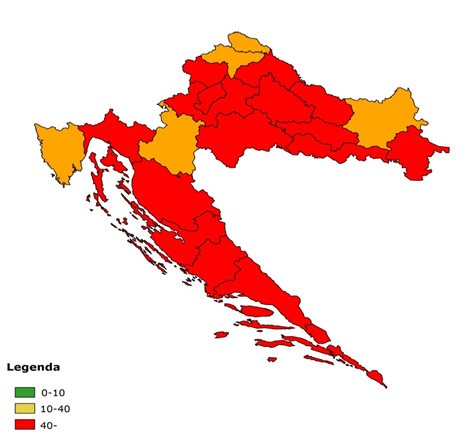
| CITY OF ZAGREB | 76,1 |
| BBC | 93,6 |
| BPC | 97,8 |
| DNC | 184,8 |
| ISTARSKA C. | 32,6 |
| KARLOVAČKA C. | 37,7 |
| KKC | 50,1 |
| KZC | 42,3 |
| LSC | 97,4 |
| MEĐIMURSKA C. | 21,8 |
| OBC | 33,5 |
| PSC | 147,4 |
| PGC | 57,3 |
| SMC | 43,1 |
| SDC | 195,3 |
| ŠKC | 104,8 |
| VARAŽDINSKA C. | 25,2 |
| VPC | 107,6 |
| VSC | 53,8 |
| ZADARSKA C. | 117,7 |
| ZAGREBAČKA C. | 53,0 |
| TOTAL | 81,4 |
Figure 1. 14-day rate by counties
Epidemic by weeks, from 19 th – 29 th week of the epidemic
In the period from 29 th of June to 13th of September 2020, the number of cases per week (from the 19 th to the 29th week of the epidemic) was from 460 to 1,948 and the rate from 11.3 to 47.6 per 100,000 inhabitants. The number of tests performed per week was ranged from 7,957 to 24,722 and the share of positive tests in those tested per week ranged from 4.3 to 12.5%. During this period, the weekly number of cases and the percentage of positive tests in the weekly number of tested varied. An overview is given in Table 1.
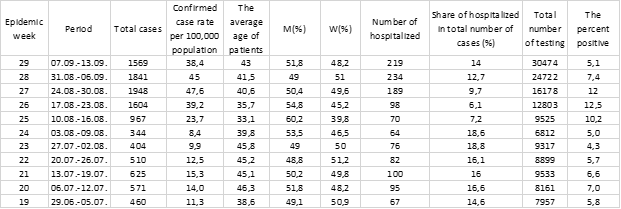
Table 1. Overview of the number of confirmed cases by weeks, from week 19 th – 29 th
In the period from 29 th of June to 14th of September 2020, the number of cases per week (from the 19 th to the 29th week of the epidemic) was from 460 to 1948. The number of deceased varied from 1-16 and showed increase in the 29th week of the epidemic. The share of deceased on the respirator ranged in the weekly number of deaths from 16.7-60%. The mean age of deceased was 75 years or more, except in the 21 st week of the epidemic, when the mean age of death cases was 72,7 years.
The death rate ranged from 0.1 in the 19 th week of the epidemic to 0.3 in the 23rd and 28 th week of the epidemic with an increase in the 29 th week of the epidemic when it was 0.6. An overview is given in Table 2.

Table 2. Overview of patients on respirator and deaths by weeks, from week 19 th – 29 th
Table 3 shows the incidence of the 7-day rate in the two last weeks with a limit of 50/100 000 inhabitants, which in some countries is taken as one of the criteria in assessing the epidemiological situation. In most counties, the 7-day rate is generally stable or slightly declining.
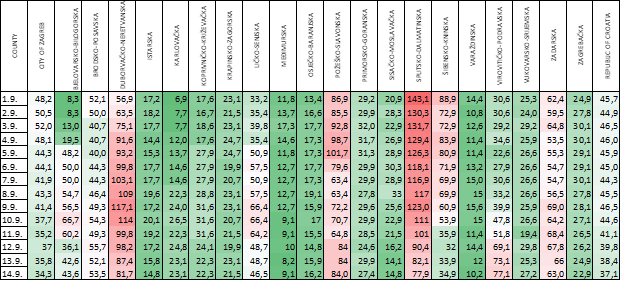
Table 3. Overview of 7-day incidence rates per 100,000 population in the last week
Clinical aspects – hospitalized, on a respirator and recovered in the last week
Figure 2 shows the relationship between the daily number of confirmed cases and the daily number of hospitalized cases. Number of hospitalized cases per day ranged between a minimum of 17 and a maximum of 42, while the share of hospitalized cases in the total daily number of confirmed cases ranged from 9.7% to 26.2%.
Figure 2. Overview of the daily number of confirmed and hospitalized cases (8.9.-14.9.)
Figure 3 shows the proportion of hospitalized in the total number of weekly cases. In the last week, 230 people were hospitalized, which is 14% of the total number of patients in the given period. In the same period, 16 people were put on a respirator, which makes 1,1% of the total number of confirmed cases.
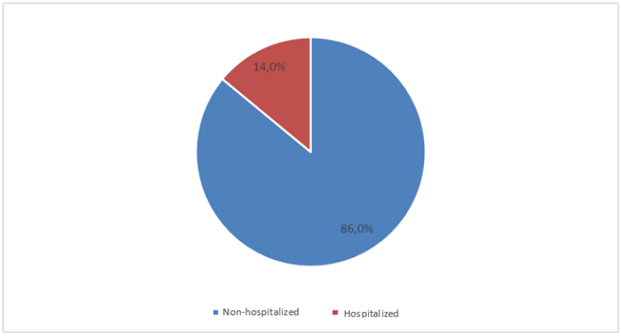
Figure 3. Relation of the total number of confirmed and hospitalized cases (8.9.-14.9.)
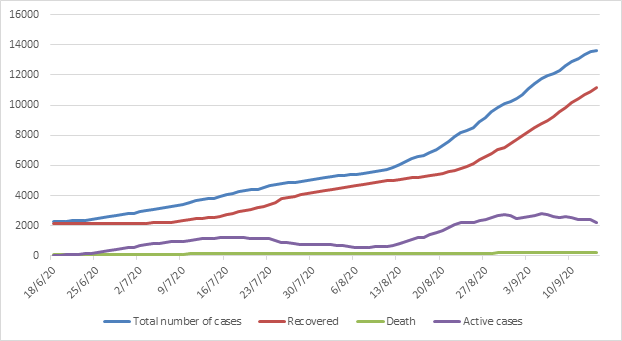
Figure 4. Total number of cases, recovered, deceased and active number of cases from 18.6.- 14.9.
Died from COVID-19, 8 th of September – 14 th of September 2020, age and sex
A total of 120 people died in this wave of epidemics. Most of the people who died had significant comorbidities or were of advanced age. The mean age of the deceased in this wave of epidemics is 76.4 years. Forty-eight people died on a respirator.
An overview of the situation is given in Table 4 and Figure 5.
| AGE GROUP | 40-49 | 50-59 | 60-69 | 70-79 | 80-89 | 90-99 | 100+ |
| MEN | 1 | 7 | 15 | 30 | 17 | 4 | 0 |
| WOMEN | 0 | 0 | 6 | 9 | 25 | 5 | 1 |
Table 4. Distribution by age and sex of the deceased persons
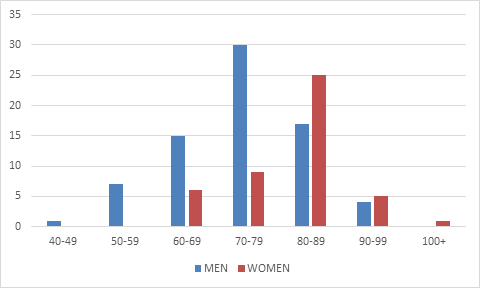
Figure 5. Age and sex distribution of deaths from COVID-19 in the period 29 th June – 14th of September 2020
In the last week, 26 people died, of which 10 (38.5%) were on a respirator. The distribution by age and sex in the last weeks is shown in Table 5, and by counties in Table 6.
| AGE GROUP | 40-49 | 50-59 | 60-69 | 70-79 | 80-89 | 90-99 |
| MEN | 1 | 2 | 1 | 6 | 6 | 3 |
| WOMEN | 0 | 0 | 2 | 2 | 3 | 0 |
Table 5. Distribution by age and sex of the deceased people in the last week
Hotspots
In the last week, new cases were recorded in all counties of continental Croatia, but mostly in the City of Zagreb, Brodsko – posavska and Zagrebačka County. The highest 7-day rates on 14 th of September were in Požeško – slavonska, Virovitičko – podravska and Brodsko – posavska County. There is still influx of patients whose source of infection is associated with holidays on the Adriatic, but their share is significantly reducing. The number of wedding celebrations at which patients were registered increased, but at most there was no large spread among the guests. A larger influx of patients was recorded at wedding celebrations in Brodsko – posavska, Varaždinska, Bjelovarsko – bilogorska and Vukovarsko – srijemska Counties. In Požeško – slavonska County, patients are recorded in connection with the prom dinner and the sacral event. In the City of Zagreb, a grouping of patients was recorded in connection with an organized event in the Splitsko – dalmatinska County. The grouping of patients was recorded in health care institutions in the City of Zagreb, Brodsko – posavska and Virovitičko – podravska Counties and institutions for social care in Sisačko – moslavačka County. Cases of the disease have also occurred in schools, but there has been no significant spread among students and staff. Part of the sick people are cases imported from abroad and there is a large proportion of contacts of sick people.
Coastal Croatia
Cases of ill persons have been recorded in Coastal Croatia like in all counties as well. The highest number of patients was recorded in the Splitsko – dalmatinska, Dubrovačko – neretvanska and Zadarska County. The highest 7-day rate is in the Splitsko – dalmatinska, Dubrovačko – neretvanska and Zadarska County. In the Splitsko – dalmatinska County, smaller groupings were recorded in two monasteries. In the Primorsko – goranska County, a significant number of patients was recorded this week as well, related to an organized cultural event in the open air and a smaller grouping of patients was also recorded in the preschool institution in the Istria County. In Zadarska County, there are two kindergartens in self-isolation and a class in one school building. Groupings of patients were also recorded at the workplace in Dubrovačko – neretvanska County and Šibensko – kninska County. The patients were also recorded in a home for the elderly in Ličko – senjska County. There were patients from wedding celebrations in Zadarska County and Ličko – senjska County, as well as in the continental part of Croatia. Although sick people have appeared at multiple weddings, there wasn’t a great spreading among guests. A significant proportion of patients are contacts of previously recorded cases.
Age-sex distribution of patients in the last week
In the previous week, a total of 1,517 people fell ill – approximately the same number of males, 732 (48.3%) and females, 785 (51.7%). The same distribution by sex is present in most age groups, except in the age group 1-6 years where twice as many girls were recorded and in the age group 41-50 years of age where more women became ill than men.
By age groups – 160 children fell ill and they make the smallest share (10.5%) in the ill people in the past week. The least affected were children under 1 year of age, a total of 2, and children in lower grades of primary school, a total of 15. The most affected were children of secondary school age, a total of 33. In general, adults made the largest share in the total number of patients last week 1142 (75,3 %).
In contrast to previous weeks, there is a shift in the age of patients towards higher age groups. The largest share, 21.9% (332 cases) are people aged 51-65, while a one – fifth of patients (145 or 18.9%) in the last week are young adults aged 19 to 30 years. The lowest number of patients in the age group is 66 and older (215 or 14.2%), although this number is not negligible because it is in this group of patients that the highest number of concomitant comorbidities is observed, which are associated with increased risk in COVID-19 from the development of a more severe clinical picture.
The full view can be found in Figure 6 and Table 6.
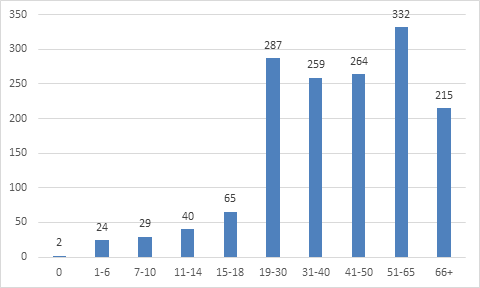
Figure 6. Distribution of patients in the last week by age groups
Measures
Measures to maintain physical distance, maintain hand hygiene and disinfection are still in force. Also, it is mandatory to wear face masks or medical masks indoors for all health workers and professionals, employees who work in social care system and the ones who work in hospitality facilities
Decisions of the Headquarters
- September 8 – Decision about amendments to the Decision about the introduction of necessary epidemiological measures for the Brodsko – posavska County
- September 8 – Decision about the introduction of new epidemiological measures for the area of the City of Otočac
- September 9 – Decision about amendments to the Decision about the introduction of necessary epidemiological measures for the area of Zadarska County
- September 9 – Decision amending the Decision about the introduction of necessary epidemiological measures for the area of Splitsko – dalmatinska County
- September 11 – Decision amending the Decision about the introduction of necessary epidemiological measures for the area of Dubrovačko – neretvanska County
- September 11 – Decision about the introduction of necessary epidemiological measures for the area of Virovitičko – podravska County
- September 11 – Decision about the introduction of necessary epidemiological measures for the Zagrebačka County
CIPH recommendations
- Recommendations for the prevention of COVID-19 infection in the activity of multiplex cinemas in shopping malls
- Instructions for the implementation of the state matriculation exam during the coronavirus epidemic (COVID-19) autumn deadline – August and September 2020
- Supplement to the recommendation for the prevention of COVID-19 infection in the catering industry of nightclubs
- Possibilities of conducting extracurricular classes related to the COVID-19 pandemic
- Instructions for prevention and suppression of the COVID-19 epidemic related to the work of preschool institutions, primary and secondary schools in the school year 2020/2021.
- Recommendations for manufacturers of textile masks intended for schools
- Guidelines for the prevention and control of the COVID-19 epidemic in student dormitories with regard to the COVID-19 epidemic in the school year 2020/2021.
- Recommendations for the operation of dance schools during the coronavirus epidemic (COVID-19)
- Recommendations for the operation of art schools during the coronavirus epidemic (COVID-19)
- Priorities for testing for SARS-CoV-2, on contact handling, completion of isolation and self-isolation (Consolidated revised recommendations)
- Diseases and health conditions that may increase the risk for more severe forms of COVID-19 disease
- Selected health and organizational issues related to the work of preschool institutions, primary and secondary schools in the school year 2020/2021
- Recommendations for teaching at higher education institutions in the period of the COVID-19 pandemic with the application of anti-epidemic measures
- Organization of rest and food – Work of preschool institutions, primary and secondary schools in the school year 2020/2021 – additional clarifications
- Visors cannot replace masks except when a student / person has a problem with hearing impairment – Work of preschool institutions, primary and secondary schools in the school year 2020/2021 – additional clarifications
Recommendations and measures on global and EU level
Europe
On 10th of August 2020, ECDC released an updated version of the risk assessment. ECDC has additional documents and information available:
The number of cases and the 7-day cumulative incidence of COVID-19 confirmed cases worldwide can be found on the ECDC dashboard:
https://qap.ecdc.europa.eu/public/extensions/COVID-19/COVID-19.html
Austria
Bundesministerium für Soziales, Gesundheit, Pflege und Konsumentenschutz – https://www.sozialministerium.at/Informationen-zum-Coronavirus/Neuartiges-Coronavirus-(2019-nCov).html
Netherlands
Government of the Netherlands – https://www.government.nl/topics/coronavirus-covid-19
National Institute for Public Health and the Environment – https://www.rivm.nl/en/novel-coronavirus-covid-19
Germany
Rober Koch Institut – https://www.rki.de/DE/Home/homepage_node.html
Slovenia
(gov.si) – https://www.gov.si/en/topics/coronavirus-disease-covid-19/
National Institute for Public Health – Slovenia – https://www.nijz.si/en
United Kingdom
gov.uk – https://www.gov.uk/coronavirus
NHS – https://www.nhs.uk/conditions/coronavirus-covid-19/
World
WHO provides comprehensive information and documents. WHO COVID-19-Dashboard:
Coronavirus disease (COVID-19) Weekly Epidemiological Update and Weekly Operational Update i Weekly Surveillance Report:
- https://www.who.int/emergencies/diseases/novel-coronavirus-2019/situation-reports
- https://www.euro.who.int/en/health-topics/health-emergencies/coronavirus-covid-19/weekly-surveillance-report
Sources of information
https://www.hzjz.hr/
https://zdravlje.gov.hr/
Information about the global epidemiological situation
More about COVID-19 in other countries can be found and learned on the ECDC website: https://www.ecdc.europa.eu/en/geographical-distribution-2019-ncov-cases
The WHO Regional Office for Europe, the European Commission and the European Observatory on Health Systems and Health Policy have at their disposal the COVID-19 Health System Response Monitor (HSRM). There is information available about European countries and ways to respond to this epidemic. The focus is on health systems and public initiatives: https://www.covid19healthsystem.org/mainpage.aspx
For the latest travel info, bookmark our main travel info article, which is updated daily.
Read the Croatian Travel Update in your language – now available in 24 languages!
Join the Total Croatia Travel INFO Viber community.










